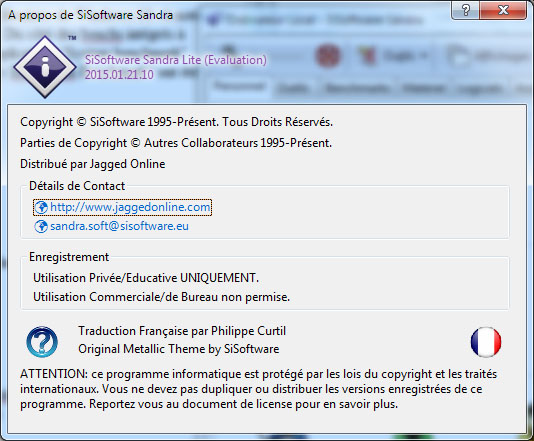L’éditeur SiSoftware dévoile Sandra 2015

Le programme d’informations et de benchs SANDRA de l’éditeur SiSoftware continue son petit bonhomme de chemin et nous arrive maintenant en version 2015.
Pour information, SANDRA 2015 supporte maintenant Windows 10 Technical Preview et il est pleinement compatible avec les derniers outils et les dernières librairies de Windows 10. A noter que le programme prend désormais également en charge les très hautes définitions et les écrans de type Rétina (et plus) de 192 ppp (ou supérieur). Du côté des benchs intégrés à SANDRA 2015, plusieurs mises à jour ont également été effectuées comme on peut le voir dans le changelog ci-dessous. En particulier, les applications « System benchmark », « Crytography CPU Benchmark », « GP Benchmarks », « CPU Multi-Media Benchmark », « Memory Bandwidth Benchmark » et « Cache & Memory Bandwidth Benchmark » ont été améliorées et optimisées.
-> Télécharger Sandra 2015 (version 2015.01.21.10)
Changelog officiel de Sandra 2015 (en anglais) :
* Support for Windows 10* Tech Preview
– Updated to the latest tools & libraries for forthcoming Windows 10, with various minor compatibility changes and support for new APIs, technologies as well as hardware.
– Will support DirectX 12.
– Support for very-wide SIMD AVX-512 family.
– Updated resources for high-DPI (retina+) up to 200% 192ppi or higher – e.g. huge 256×256 icons.
* Updated System benchmark: Overall Score 2015
– Removed .Net/Java Multi-Media (vectorised) benchmark as current JVM/CLR do not vectorise even today.
– Added CPU Scientific (GEMM, FFT, N-Body), CPU Financial (Binomial, Monte Carlo, Black-Scholes) Analysis – while GPGPUs do accelerate these complex algorithms, wide-SIMD (e.g. AVX-512F) can significantly accelerate them in large CPUs with many cores and large caches (e.g. 12C+ 24MB L3/128MB L4)
– Added GP Scientific Analysis (GEMM, FFT, N-Body) (using CUDA, OpenCL, DirectX Compute) – to match CPU Scientific
– Updated weights to match modern devices (mobile, laptop, desktop and server)
* Updated Crytography CPU Benchmark
– Optimised AES HWA code-path for improved performance across hardware constrained by memory bandwidth.
* Uptimised GP Benchmarks
– GP Cryptography – optimised AES code-path.
– GP Scientific – optimised N-Body path.
– GP Financial – optimised Binomial Options path.
* Updated CPU Multi-Media (SIMD) Benchmark
– Combined score is now made of « combined integer (int32 and int64) » and « combined floating-point (single and double) » SIMD performance. Sandra 2014 used « int32 single-float and double-float » only.
– Combined integer averages int32 (32-bit integer) and int64 (64-bit integer) SIMD performance (SSE, SSE2, AVX, AVX2) – and thus measure also 64-bit integer performance that is extensively used today.
– int128 (quad-integer emulated) and quad-precision float-point (emulated, mantissa precision extended) is also measured but not included in the index as both are emulated at this time. Once native SIMD support is available in hardware, they will be added to the index.
* Updated Memory Bandwidth Benchmark
– Now reports average (rms – root mean sqare) not maximum performance. Some scores *will* be lower depending on the hardware, usually 3-5%. You can use the « maximum value » as index if you want to match Sandra 2014 and earlier.
* Updated Cache & Memory Bandwidth Benchmark
– Now reports average (rms – root mean sqare) not maximum performance. Some scores *will* be lower depending on the hardware, usually 5-20%. You can use the « maximum value » as index if you want to match Sandra 2014 and earlier.

Désolé, les commentaires sont fermés.